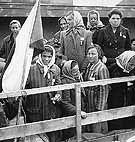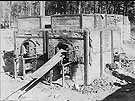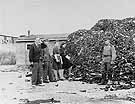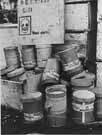
|
|
|

|

|

|

|
|
Click on an image to see a larger, more detailed picture.
|
|
|
|
|
| 1945: Liberation and Rebuilding |

|
pg. 621 |

|
|
|
|
| |
 Eventually, of course, survivors left the camps, either to return home or to emigrate. The Holocaust had displaced millions, especially in Eastern Europe. These women were photographed as they left the labor camp in Theresienstadt.
Eventually, of course, survivors left the camps, either to return home or to emigrate. The Holocaust had displaced millions, especially in Eastern Europe. These women were photographed as they left the labor camp in Theresienstadt.
Photo: Archive Photos
|
 These outdoor ovens were located at the concentration camp at Stutthof, Poland. Usually they would have been housed in a crematorium building, but in this case Nazi engineers improvised, probably to maintain the pace of cremations. Killing several million people was a very expensive undertaking, a cruelly practical consideration of which the Nazis were keenly aware.
These outdoor ovens were located at the concentration camp at Stutthof, Poland. Usually they would have been housed in a crematorium building, but in this case Nazi engineers improvised, probably to maintain the pace of cremations. Killing several million people was a very expensive undertaking, a cruelly practical consideration of which the Nazis were keenly aware.
Photo: Muzeum Stutthof/United States Holocaust Memorial Museum Photo Archive
|
 Two Soviet soldiers and three civilians stand near a mountain of victims' shoes at the Gross-Rosen camp in Germany. At its height, the Gross-Rosen complex included 77 satellite camps and at least 80,000 prisoners, most of whom performed slave labor. The Nazis evacuated the camp in February 1945, shipping out prisoners on wagons or death marches.
Two Soviet soldiers and three civilians stand near a mountain of victims' shoes at the Gross-Rosen camp in Germany. At its height, the Gross-Rosen complex included 77 satellite camps and at least 80,000 prisoners, most of whom performed slave labor. The Nazis evacuated the camp in February 1945, shipping out prisoners on wagons or death marches.
Photo: Main Commission for the Investigation of Nazi War Crimes/United States Holocaust Memorial Museum Photo Archive
|
 By June 1944, Zyklon B was the preferred method for gassing concentration-camp prisoners at Stutthof. It was an easy, relatively economical way to kill many people quickly. These cans of the deadly pesticide were captured by Soviet troops at Stutthof before they could be put to use.
By June 1944, Zyklon B was the preferred method for gassing concentration-camp prisoners at Stutthof. It was an easy, relatively economical way to kill many people quickly. These cans of the deadly pesticide were captured by Soviet troops at Stutthof before they could be put to use.
Photo: State Achives of the Russian Federation/United States Holocaust Memorial Museum Photo Archive
|
|

|

|

|
|
|
|
|
| 1945: Liberation and Rebuilding |

|
pg. 621 |

|
|
The Holocaust Chronicle
© 2009 Publications International, Ltd.
|
|
